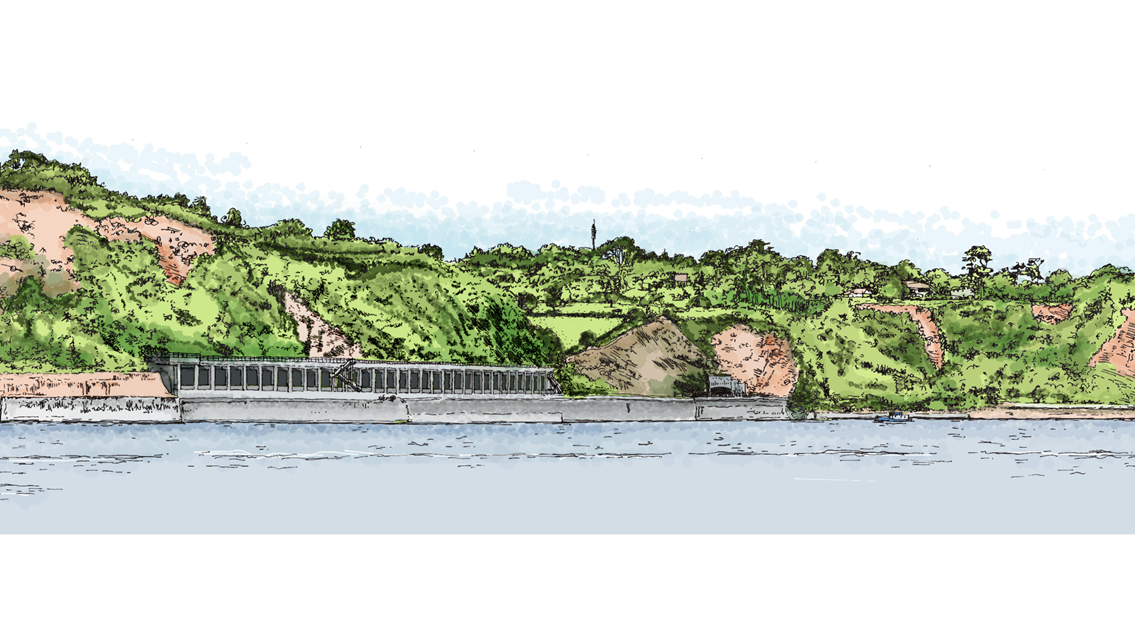Thursday 25 Feb 2021
Plans submitted for rockfall shelter extension to protect vital stretch of railway in Devon
- Region & Route:
- Wales & Western
- | Wales & Western: Western
Network Rail has submitted plans to Teignbridge District Council to extend an existing rockfall shelter over the railway line between Dawlish and Holcombe.
The 209m long extension of the rockfall shelter north of Parsons Tunnel will help protect trains against falling rocks along this section of vital stretch of railway that connects communities across the south west with the rest of the UK, which is home to a number of cliffs in close proximity to the railway line.
Parsons Tunnel was previously extended a hundred years ago and Network Rail proposes to extend that further by providing a rockfall shelter in modern materials, but with open sides rather than the previous brick built enclosed tunnel extension.
If approved, the proposals, which are subject to funding confirmation from government, will see construction starting in August with the work expected to take around a year to complete.
Preparatory work is due to begin at the top of the cliffs overlooking this stretch of railway on 22 March whereby Network Rail engineers will begin cutting back some of the vegetation and installing safety netting to secure the shrubbery on the cliffs and reduce any falling debris. This work will be closely monitored to ensure the least disruption for wildlife habitats and biodiversity.
This rockfall shelter, which is the third phase of work as part of Network Rail’s South West Rail Resilience Programme following the two sections of new sea wall in Dawlish, is critical to ensuring the resilience of the railway between Dawlish and Teignmouth for generations to come and protecting this critical route from failing debris.
Rocks falling from the cliffs is not a new problem and was the reason for the construction of the original enclosed shelter a century ago. However, recent studies, including drone flights over the cliffs, show that there are active falls from the rear cliff. An accumulation of material on the slope could trigger larger debris slides and this stretch of railway is not currently protected against rock falls from this active area of cliffs above.
The construction of the rockfall shelter at this location poses a number of engineering challenges, due to the limited access with the track flanked by high cliffs on one side and the sea on the other, as well as ensuring this work doesn’t result in lengthy closures of this critical rail artery to the south west.
The design of the new rockfall shelter is open-sided to allow rail passengers to enjoy the views of the beautiful south west coastline. It will be constructed out of pre-made concrete wall panels and beams on the roof, covered by a cushioning material to absorb the impact of any rockfalls.
Network Rail has submitted the plans for ‘prior approval’ under Network Rail’s permitted development rights. Under this, Teignbridge District Council will consider only the design, materials, or siting of the project to ensure that development ‘would not injure the amenities of the neighbourhood’ and be satisfied that it could not be ‘reasonably carried out elsewhere’.
Teignbridge District Council will now be able to formally consult the local community on the proposed designs.
Environmental protection is a key focus for the project and, following early feedback from Teignbridge District Council, Network Rail has carried out additional studies and submitted reports that set out its approach to ecological protection and management of potential impacts on wildlife habitats.
Ewen Morrison, senior programme manager for Network Rail’s South West Rail Resilience Programme, said: “The coastal location of the railway in south Devon is truly stunning but it also presents its biggest challenge with the sea on one side and steep cliffs on the other.
“The existing rockfall shelter has proven its effectiveness for a century and so this modern extended structure will protect the railway for generations to come alongside a section of cliff that is becoming increasingly hazardous from rock falls.”
Councillor Andrea Davis, Chair of Peninsula Rail Task Force (PRTF), said: “The PRTF welcomes the planning submission for the extension of the rockfall shelter north of Parsons Tunnel. The line at Dawlish is a vital link between the peninsula and the rest of the UK and the rockfall shelter is an important element in future proofing and improving the resilience of our main line.
“We congratulate Network Rail on developing a modern, ecologically conscious, solution to the ongoing rock fall issue. The PRTF look forward to continuing our work with government to build upon efforts to level up the region, focussing on the next stage of the project which will deliver a resilient rail infrastructure, fit for the future.”
Contact information
Passengers / community members
Network Rail national helpline
03457 11 41 41
Latest travel advice
Please visit National Rail Enquiries
Journalists
Rob Breckon
Head of Communications - Eastern
Network Rail
07395 390759
rob.breckon@networkrail.co.uk
About Network Rail
We own, operate and develop Britain's railway infrastructure; that's 20,000 miles of track, 30,000 bridges, tunnels and viaducts and the thousands of signals, level crossings and stations. We run 20 of the UK's largest stations while all the others, over 2,500, are run by the country's train operating companies.
Usually, there are almost five million journeys made in the UK and over 600 freight trains run on the network. People depend on Britain's railway for their daily commute, to visit friends and loved ones and to get them home safe every day. Our role is to deliver a safe and reliable railway, so we carefully manage and deliver thousands of projects every year that form part of the multi-billion pound Railway Upgrade Plan, to grow and expand the nation's railway network to respond to the tremendous growth and demand the railway has experienced - a doubling of passenger journeys over the past 20 years.
Follow us on Twitter: @networkrail
Visit our online newsroom: www.networkrailmediacentre.co.uk

